SUMMARY
This is AI generated summarization, which may have errors. For context, always refer to the full article.
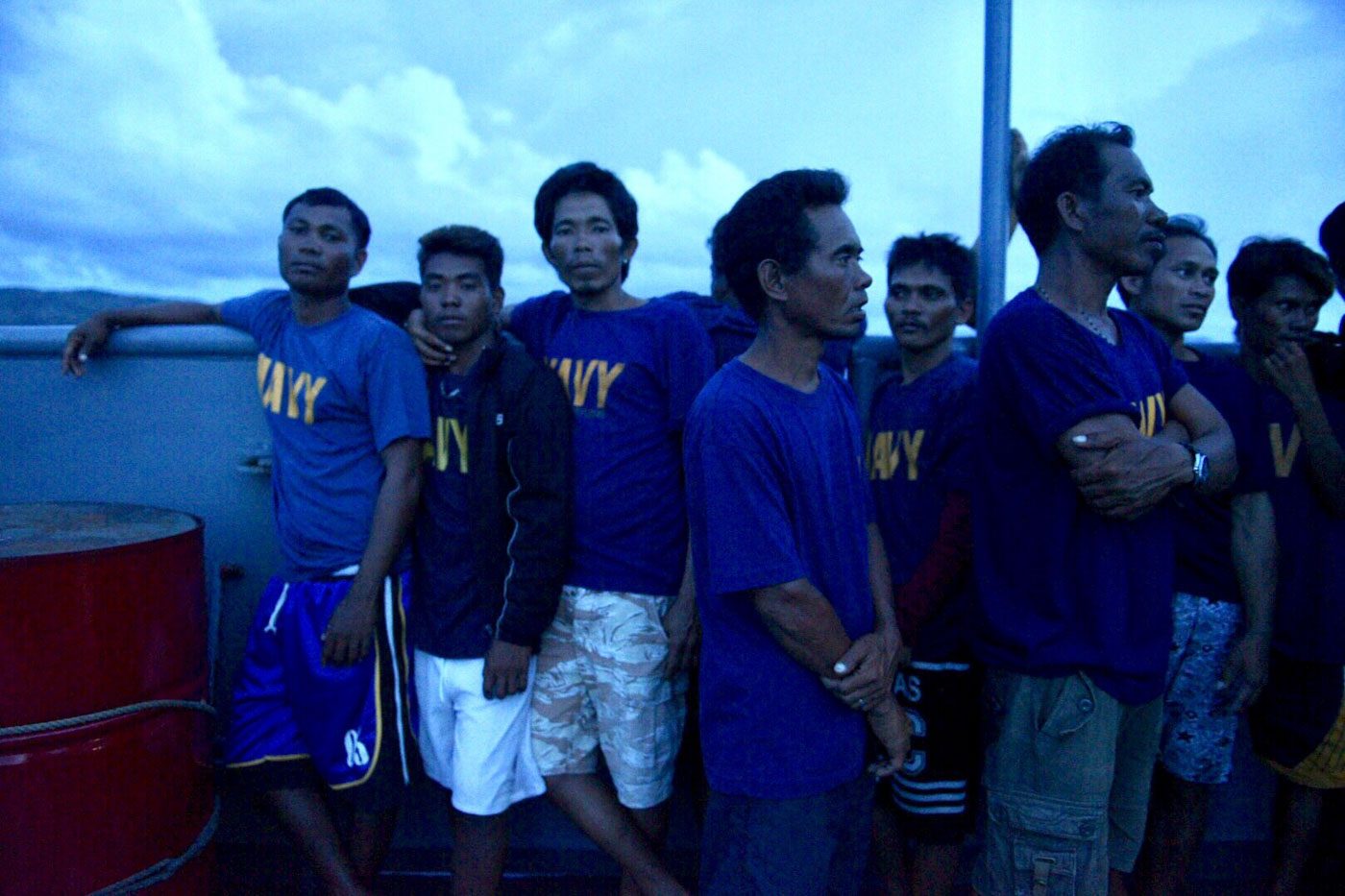
This compilation was migrated from our archives
Visit the archived version to read the full article.
READ: Part 1 | THE SINKING OF GEM-VER: Barko! May babanggang barko!
I. ‘Daplis lang’
The men of Gem-Ver almost drowned in the middle of the West Philippine Sea on June 9, their boat gutted from the ramming of a Chinese vessel at least twice its size. But Alfonso Cusi made light of their ordeal.
“Daplis lang (It was just a graze),” said the alter ego of President Rodrigo Duterte minutes after arriving in San Jose, Occidental Mindoro, to bring cheer to the fishermen. If the Chinese meant harm, Gem-Ver and its men would have been swallowed by the sea, he said.
It was past 10 am on June 16, two days after the Filipino fishermen returned from Recto Bank and the 4th day that the nation had not heard anything from their President, when Duterte’s energy secretary arrived in San Jose in a convoy of cars. Cusi strode toward the meeting area in a black baseball cap and a pristine white Polo Club shirt, tailed by the town’s mayor, Romulo Festin, and the province’s top police and military officers.
The fishermen – some shirtless, others in a sando – knew that a VIP was coming. Policemen started swarming their village of San Roque in the early hours. In front of the stainless steel gates of the home of Gem-Ver’s owner, Felix dela Torre, were rows of chairs reserved for the fishermen, Cusi, and his entourage.
The billionaire Cusi is no stranger to these parts. Born and raised in the eastern side of the island, he earned his first million managing and eventually owning shipping and logistics companies that plied the West Philippine Sea and beyond. In the previous Arroyo administration, he headed the government’s air and sea transportation agencies. Under Duterte, he is the second wealthiest member of the Cabinet with a net worth of P1.4 billion by the end of 2018.


L-R (L) CABINET OFFICIAL. Energy Secretary Alfonso Cusi talks to the fishermen of F/B Gem-Ver during a consultation at Barangay San Roque, San Jose, Occidental Mindoro on June 16, 2019. (R) RESPONSE. Energy Secretary Alfonso Cusi tells the fishermen of Gem-Ver the government is studying what happened.
More than this, Cusi is a friend of China.
As the country’s energy secretary, he is in charge of overseeing energy exploration deals with the Asian giant, some of which involve the West Philippine Sea. In early 2017, he brought to Beijing members of the ruling party, PDP-Laban, of which he is vice chairperson, to meet with the top brass of the Communist Party of China.
Addressing the fishermen and their families who were gathered for his visit, Cusi assured them that the Duterte administration cared. The only reason the President has been quiet, he told them, was that he was busy studying what actually happened.
As the cameras rolled, Cusi rejected the fishermen’s claim that the Chinese vessel rammed their boat and intended to sink them: “Kung talagang babanggain, eh bakit kung sa kuwan ba, sabihin natin napakabulok naman nung babangga, daplis lang. Siyempre kung meant to kill, siyempre ideretso mo na.” (If they really intended to ram it, why was it just a graze? Such a poor performance. Of course, if they meant to kill, they should have hit directly.)
II. Home, at last
Before they set out to sea on May 29, the fishermen asked Gem-Ver owners to advance their salary – anywhere from P3,000 and P5,000 – to leave with their families. It was barely enough to get them through the month.
When they fish, the Gem-Ver crew’s goal is to at least pay back the money they had advanced from the boat owner. Imagine if they fail to do so. This triggers a cycle of debt, an all-too-familiar tale among the Philippines’ informal workers. In the case of the fishermen working for family-owned vessels such as Gem-Ver, they will be evicted from the crew if they repeatedly skip paying back their loans.
To the fishermen of San Jose, the sea is everything. It is what brings food to the table, what pays for their children’s schooling, and what makes their families get through the day.

HOMEBOUND. The men of Gem-Ver onboard the BRP Tausug after they were turned over to Mindoro local officials by the Philippine Navy on June 14, 2019.
This was all they could think of in the harrowing hours after a Chinese vessel sank their boat on June 9. So that when they finally arrived at the town’s port at 8 in the evening of June 14, the vague images that slowly emerged from a distance tugged at their hearts.
Their wives and mothers, mostly carrying an infant or towing a child, waited at the parallel concrete landing. They had been at the port for at least two days, camping in the heat of the summer sun, covered only by palm trees as they received trickles of news about their husbands and sons.
A crowd of over a hundred from the coastal barangay had gathered behind the families, creating a bustle that countered the sound of the waves. “Ayan na sila, oh (There they are),” one man happily said. Another pointed to Junel Insigne, “ayun ‘yung kapitan, oh (There’s the captain).”

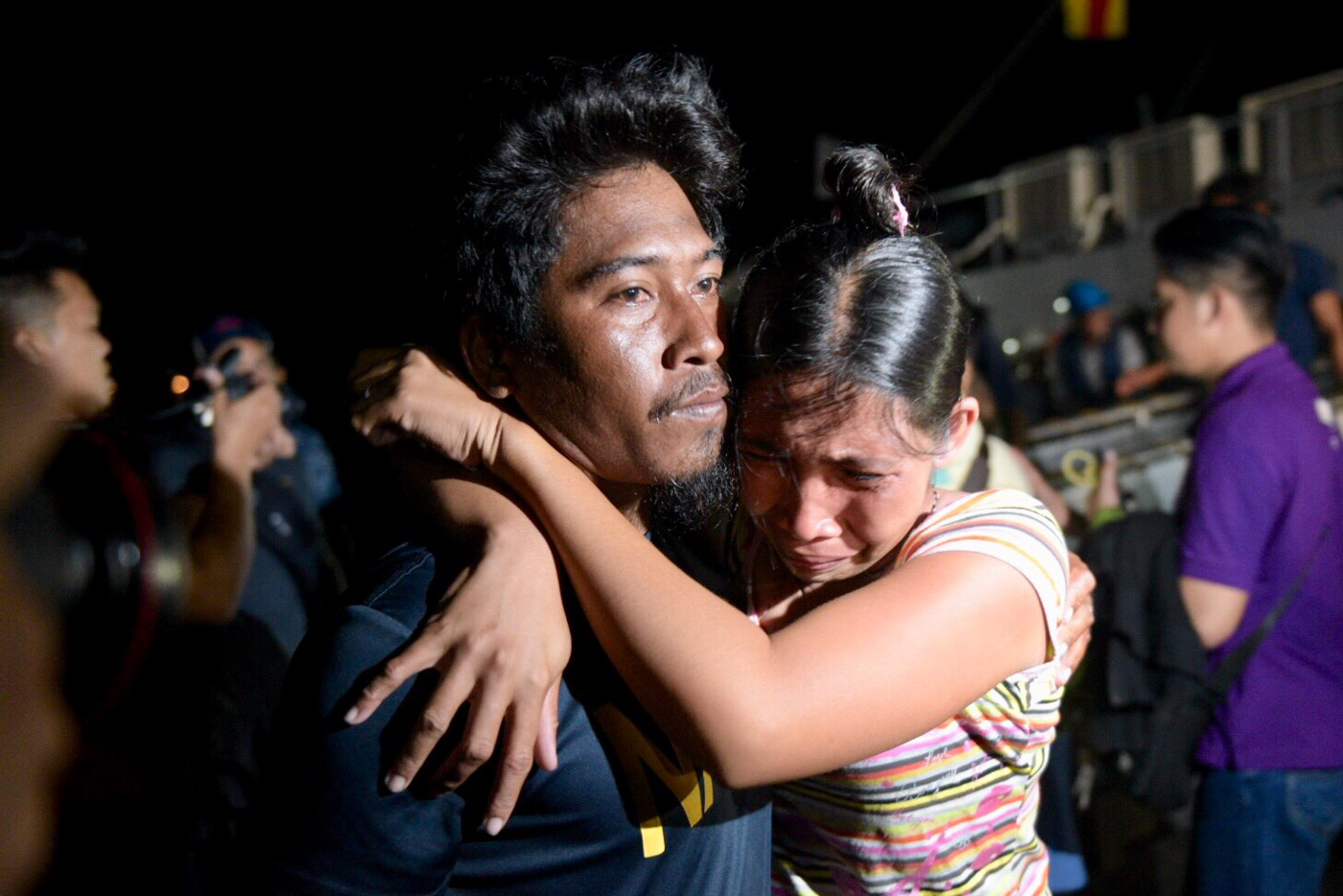
FAMILY’S ARMS. As the fishermen of Gem-Ver are reunited with their families, wives and children do not let go.
Weary from 17 days at sea, the fishermen stood side by side at the bow of the ship, lit by the port’s industry-grade lights and the moon. They shifted their eyes to locate their families, but the strong lights drowned out everything – like how the brightly-lit Chinese vessel overwhelmed them at sea. They had to wait, again, for many more minutes before they could finally walk to their kin.
In their tight embrace, the men wept.
III. Rivals at sea
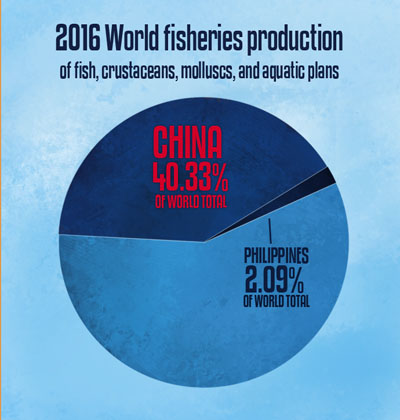
The fishermen have had good times, when they would spend days and nights in the deep ocean untrammeled. Those years are gone. Foreign boats and trawlers – bigger, faster – have started to crowd Philippine waters.
Filipino fishermen catch about 4.2 million metric tons of fish, crustaceans, molluscs, and aquatic plants a year, based on the government’s latest data in 2016. This makes the Philippines the 8th top fish-producing country in the world, sharing 2.1% of total global production. China is No. 1, catching 81.5 million metric tons a year and cornering 40.3% of world production.
From 2011 to 2013, under the Aquino government, the Philippines ranked 7th, but the country’s fish production has been declining since then due to various reasons such as global warming and competition at sea. In 2018, the Bureau of Fisheries and Aquatic Resources (BFAR) saw a slight turnaround, with Filipino fishermen hauling off some 4.33 million metric tons of fish and sea resources worth P265 billion, slightly higher than the 4.31 million metric tons in 2017.
But the increase in fish production has been attributed mainly to the aquaculture sector, which covers the catch from fishponds, fish pens, and cages in waters, along with mariculture of seaweed, oysters, and mussels. Commercial fisheries – the kind that involves conquering the deep sea like Gem-Ver does – remained on a decline.
From some 135,310 metric tons of fish captured in the ocean in 2012, the yearly commercial catch dropped to 123,781 metric tons in 2018. Filipino fishermen who were sailing past municipal waters within a 15-kilometer stretch have come to see their catch thinning each year.
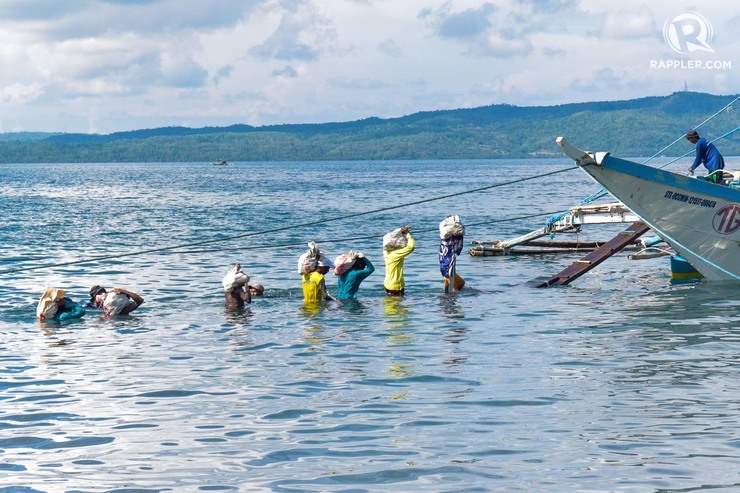
PREPARING TO WORK. Fishermen load stone sinkers on a boat headed to Recto Bank on June 21, 2019 at Barangay San Roque, San Jose, Occidental Mindoro.
To be sure, they had other fish-rich areas to conquer aside from Recto Bank. From Mindoro, they could fish as far as Panatag Shoal (Scarborough Shoal) and Panganiban Reef (Mischief Reef) off the coast of Zambales in Central Luzon.
But why risk it? They know the Chinese Coast Guard patrols those areas.
IV. Under the spotlight
Two days after Cusi’s visit came another Cabinet official, Agriculture Secretary Emmanuel Piñol, who sailed overnight from Manila to turn over fiberglass boats to the fishermen and speak with them inside the Dela Torre home.
Usually just guarded by stray dogs, the Dela Torre house on June 19 was barricaded by dozens of anti-riot policemen wearing helmets, shields, and bulletproof vests who arrived after Piñol. Other cops stood by, telling reporters and even locals to step back from the house.
Piñol sat down with the fishermen inside, where they talked for about 40 minutes. Then they all went to the San Jose municipal hall where the media was waiting. It was there that boat captain Junel Insigne, poker-faced, changed his tone and said he was no longer sure if the Chinese vessel intentionally hit Gem-Ver. Piñol seemed pleased.



L-R (1) RELIVE EVENTS. A photo of the sunken Gem-Ver and its cook, Richard Blaza, are presented to media on June 17, 2019. Photo by Darren Langit/Rappler (2) PUBLIC STATEMENT. Agriculture Secretary Emmanuel Piñol holds a press conference with 22 fishermen of Gem-Ver in San Jose Municipal Hall, San Jose, Mindoro Occidental on June 19, 2019. Photo by Inoue Jaena/Rappler (3) CAPTAIN’S WORD. Gem-Ver Captain Junel Insigne sits after speaking for his men. Photo by Inoue Jaena/Rappler
The men would have little time to breathe after that meeting. After two days, Vice President Leni Robredo followed, coming in by helicopter from Manila but without the security fanfare that attended the previous secretaries’ visits. Like Piñol, she spoke with the fishermen inside the Dela Torre home for about an hour.
Robredo then paid a surprise visit to the homes of Junel and mechanic Boy Gordiones, walking through narrow alleys covered with low-hanging tarpaulin covers. The photos and videos of that home visit captured it all: Robredo and the fishermen’s families laughing and partaking of homemade snacks.
But the exposure had taken a toll on the fishermen. They started withdrawing from the media that continued to encamp in their village, choosing to rest and spend more time with their families. Others like mechanic Boy Gordiones immediately went back to fish, but one could see the sadness in his eyes. For the unmarried ones, they started drinking as early as daylight.
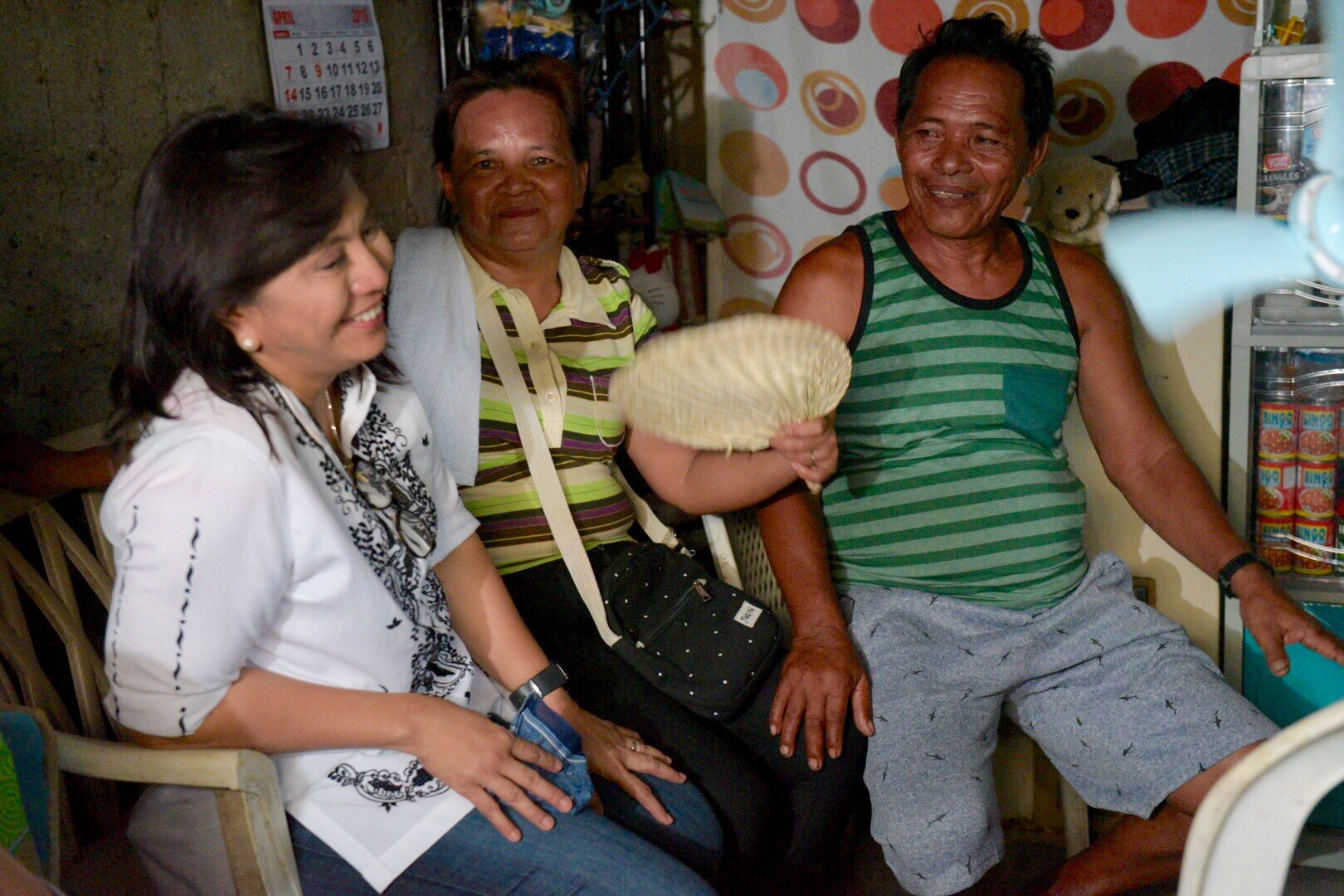
WELCOME. Vice President Leni Robredo pays a surprise visit to the home of Gem-Ver boat mechanic Boy Gordiones.
Yet peace wouldn’t come.
Three days after Robredo’s visit, a group of Filipino-Chinese businessmen followed, and this time they were able to persuade boat owner Felix dela Torre, boat captain Junel Insigne, cook Richard Blaza, and fisherman Jaypee Gordiones to fly to Manila for a public turnover ceremony of a P1.2-million check for the boat’s repair.
In a room of a restaurant tucked away in Quezon City, the fishermen posed for cameras as symbolic checks were handed to them. They were also given 50 more sacks of rice and P250,000 for all to share in the months they would be forced to remain on land. The fishermen read prepared speeches which thanked the group for their donation.
“Habang may buhay, huwag mawalan ng pag-asa, lalo na kung may suporta ang aming mga mababait ng kababayan, tulad ng Filipino-Chinese community at ng FFCCCII (As long as there is life, don’t lose hope, especially with the help of our countrymen, like the Filipino-Chinese and the FFCCCII),” Insigne read out slowly.
The event was cut short after organizers announced the fishermen could not take questions due to a meeting scheduled after the event. As they tried to make their way out of the restaurant, the men were confronted by reporters who rushed to interview them. To escape the cameras, they walked briskly to a nearby bathroom, only to see reporters blocking their single exit from the restaurant. Gem-Ver’s men kept their silence as they looked down and walked away.
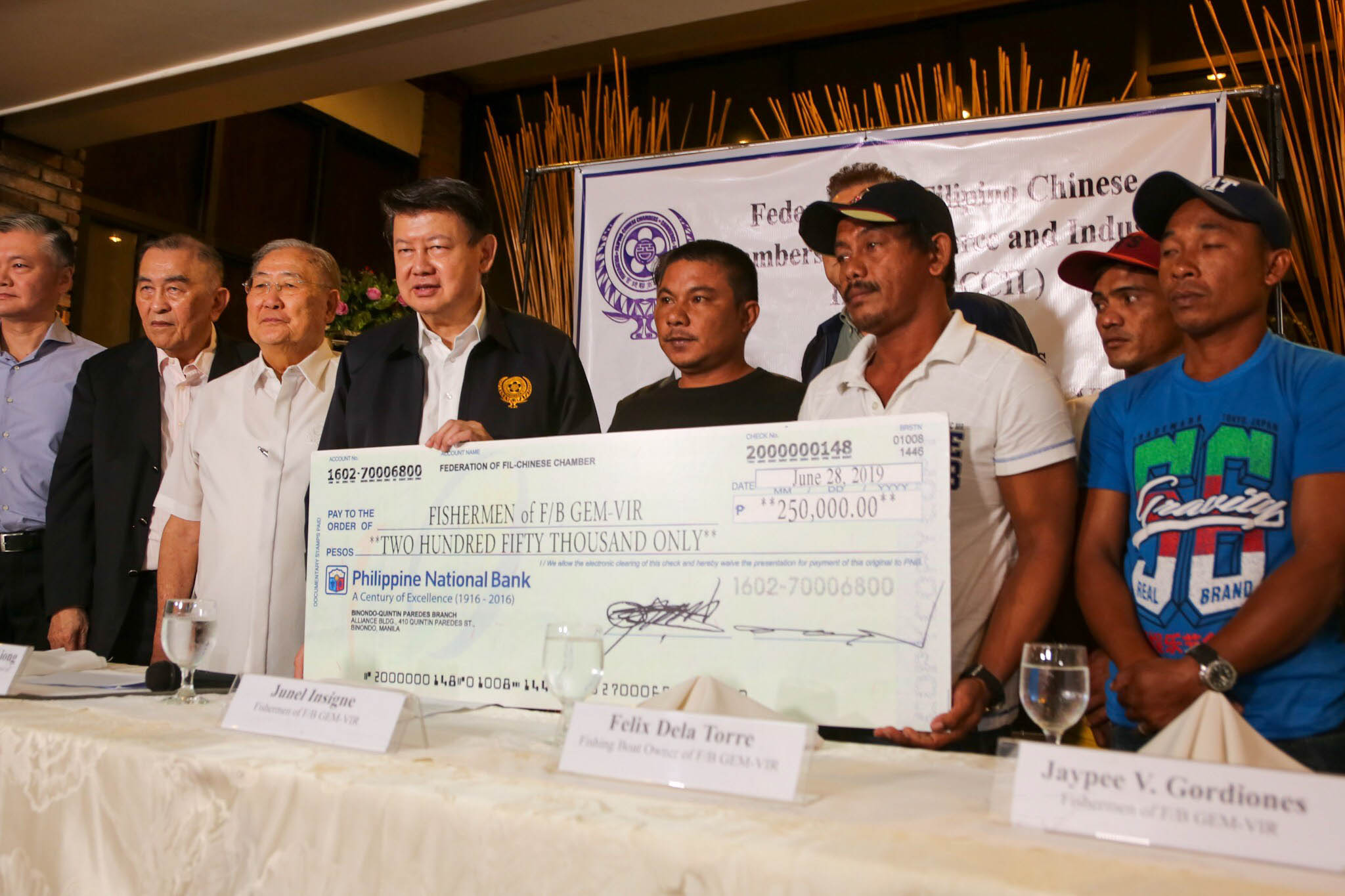
TURNOVER CEREMONY. Members of the FFCCCII turn over a check for assistance to the men of Gem-Ver in a restaurant in Quezon City on June 28, 2019. Photo by Jire Carreon/Rappler
V. A patchwork of help
The government was allowed sufficient time to plan its assistance to the fishermen, given that they arrived in San Jose two days after the news of the Recto Bank incident broke. But it’s been patchwork.
Along with officials’ efforts to downplay what had befallen Gem-Ver came a slew of uncoordinated moves and promises.
They each received from the government a total of some P60,000 in cash in addition to P25,000 each in loans. This is aside from the P50,000 given to each of them by the Office of the Vice President and the P10,000 that each received from the Department of Social Welfare and Development (DSWD). Fishermen told reporters they would use most of this to pay back their debts, including, ironically, the P25,000-loan provided to them by the Bureau of Fisheries and Aquatic Resources (BFAR).
Former foreign secretary Albert del Rosario, who was among those who defended the Philippine case vs China before the Permanent Court of Arbitration at the Hague, also donated half a million pesos to the fishermen through the Department of Foreign Affairs (DFA). But this would be returned to him after Foreign Secretary Teodoro Locsin Jr said the DFA could not dispense such donations.
At the end of it, what was left for the fishermen to spend was used to buy what they had lost at sea – cell phones, work clothes – and a few home items for their families.
Once this was done, not all knew what to do with the money they now had. Every day, a portion went to drinking that would go on from the afternoon and stretch into the night. What’s been given seemed a pittance; the damage to the boat and the loss of their catch was estimated at P2.2 million.
This excludes the months without income that would follow for the rest of the fishermen and their families, as they wait for the repair of Gem-Ver. Dela Torre said the fishing boat was passed on to him by his parents in 2011. It’s not much, he said, but it’s everything to him and his crew.
The weight of Duterte’s warm ties with China bore down on the fishermen and their families. Duterte delivered 3 speeches a day after the news broke on the Recto incident – but he never mentioned it. It felt as though “we’re slaves of China,” Dela Torre lamented. When the President finally broke his silence on June 17, he dismissed the sinking as simply a “maritime incident.”
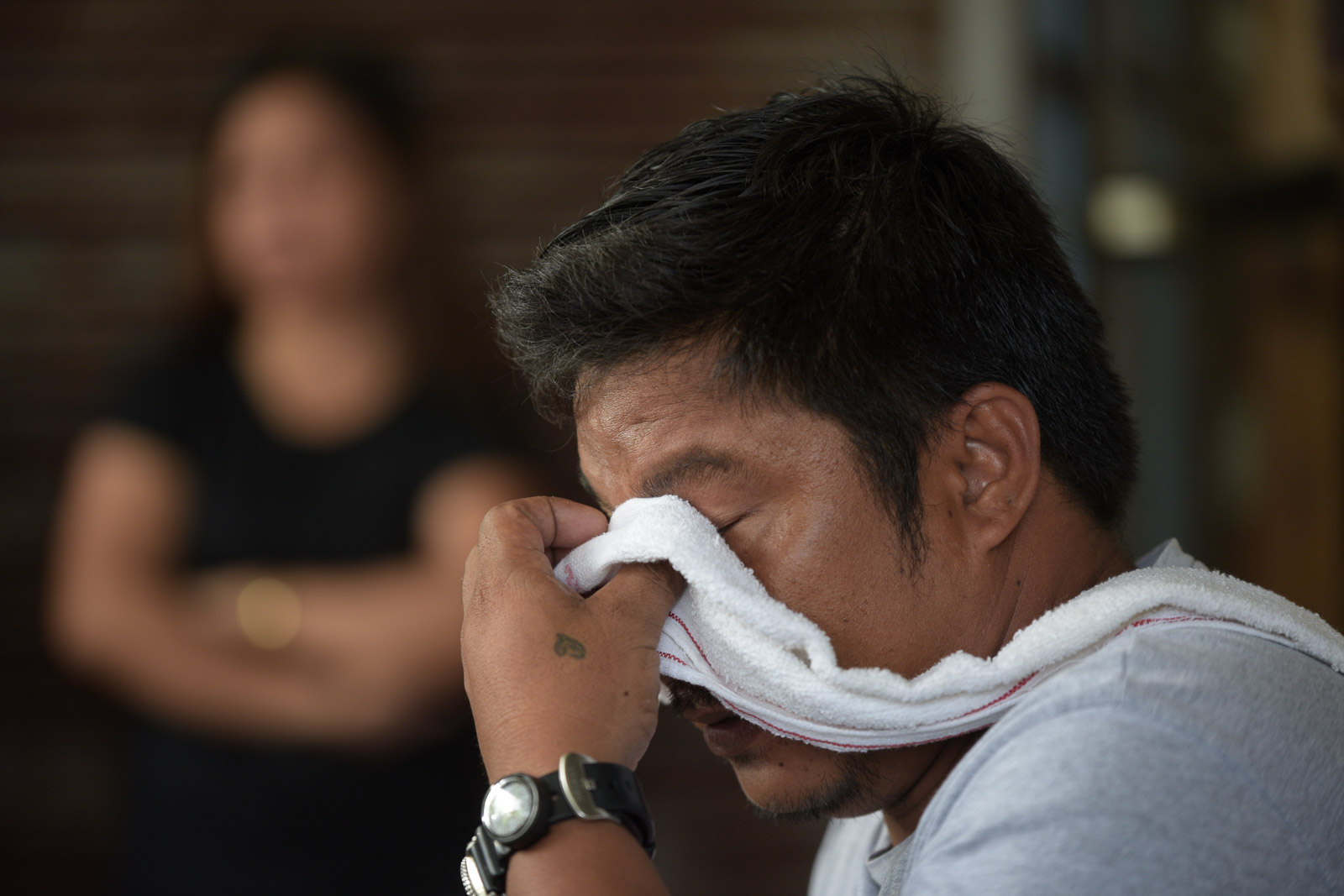

L-R (L) HOLD ACCOUNTABLE. Gem-Ver’s owner Felix dela Torre asks for justice on the shores of home in Barangay San Roque, San Jose, Occidental Mindoro on June 15, 2019. (R) RAMMED. Felix dela Torre shows an illustration of the Chinese vessel that hit Gem-Ver in the West Philippine Sea drawn by Richard Blaza.
VI. Battle of the fittest
For retired commodore Eduardo Gongona, it’s just the way things are: the strong get to do what they want while the weaker ones pay the price.
A former commander of the Coast Guard, Gongona heads the Bureau of Fisheries and Aquatic Resources (BFAR). He was enjoying retirement when he was invited to head the fisheries agency by Agriculture Secretary Piñol after a game of golf. He knows what it’s like to sail in troubled waters.
“Kung sino yung malakas, siya yung pinakikinggan ‘tsaka masaya. ‘Yung hindi malakas, siya ‘yung malungkot at puro problema…Kumbaga sa tao, that is nature,” Gongona said. (Whoever’s strong is the one listened to and the one who turns out happy…The weak are those who turn out sad and laden with problems….That’s human nature.)
Gongona’s mandate includes securing the livelihood of all Filipino fishermen, including those who collect their catch in the West Philippine Sea. There at least some 1,743 other fishing vessels that venture out to dangerous waters such as the West Philippine Sea.
While Gongona echoed his bosses in saying that the ramming of Gem-Ver was just a “simple maritime incident,” he said the Philippines should not simply let go of its sovereign rights over its waters – the right to exclusively enjoy its resources without any interruption even from so-called “friends.”
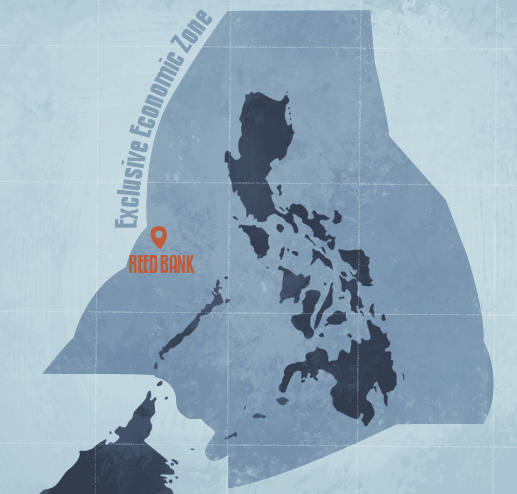
The Coast Guard and the Philippine Navy, he said, should protect the country’s waters, including its fishing waters. Why include the Navy and their gray ships? Gongona pointed out that food security is a national security issue, too, and BFAR can barely patrol all waters near the shore of the Philippines for it to go farther to the West Philippine Sea.
In his ideal world, the coast guard and the Navy should have joint patrols all over Philippine waters.
His reality is: BFAR’s 16 ships are spread thin while both the Navy and Coast Guard remain ill-equipped to guard the entire 36,289-kilometer stretch of the Philippines’ coastline – one of the world’s longest.



L-R (1) ON SHORE. Fishermen pull Gem-Ver towards the shores of Barangay San Roque, San Jose, Occidental Mindoro on June 15, 2019. (2) REST. Children play around the dry-docked Gem-Ver on June 21, 2019. (3) GEM-VER’S MEN. Gem-Ver dry-docked at Barangay San Roque, San Jose, Occidental Mindoro on June 16, 2019.
VII. Headed out to sea
Boy Gordiones still couldn’t decide what he should call it. Should it be after his own name and his son’s or after what he had just gone through? F/B Boy Jan Jan or F/B Survivor? Obviously, his fishermen friends egged him to choose the latter.
With 3 apprentices, Boy drilled, hammered into, and polished his new aqua blue fiberglass boat on the shores of San Roque. They labored under the shade of trees, just around 50 paces away from the Dela Torre home.
The boat was bare when it was given to him by BFAR, but on June 23 – two weeks after the ramming – it appeared ready to go to shore. Boy fortified its sides with more layers of wood. Unlike other small fishing boats, the entire front half of his boat was covered with removable planks. Boy said this would be the same for the rear, where the engine would be installed.
The reinforcements, he said, were a shield for him and his son against the waves. Give him more days, and the boat would be prepared for battle.
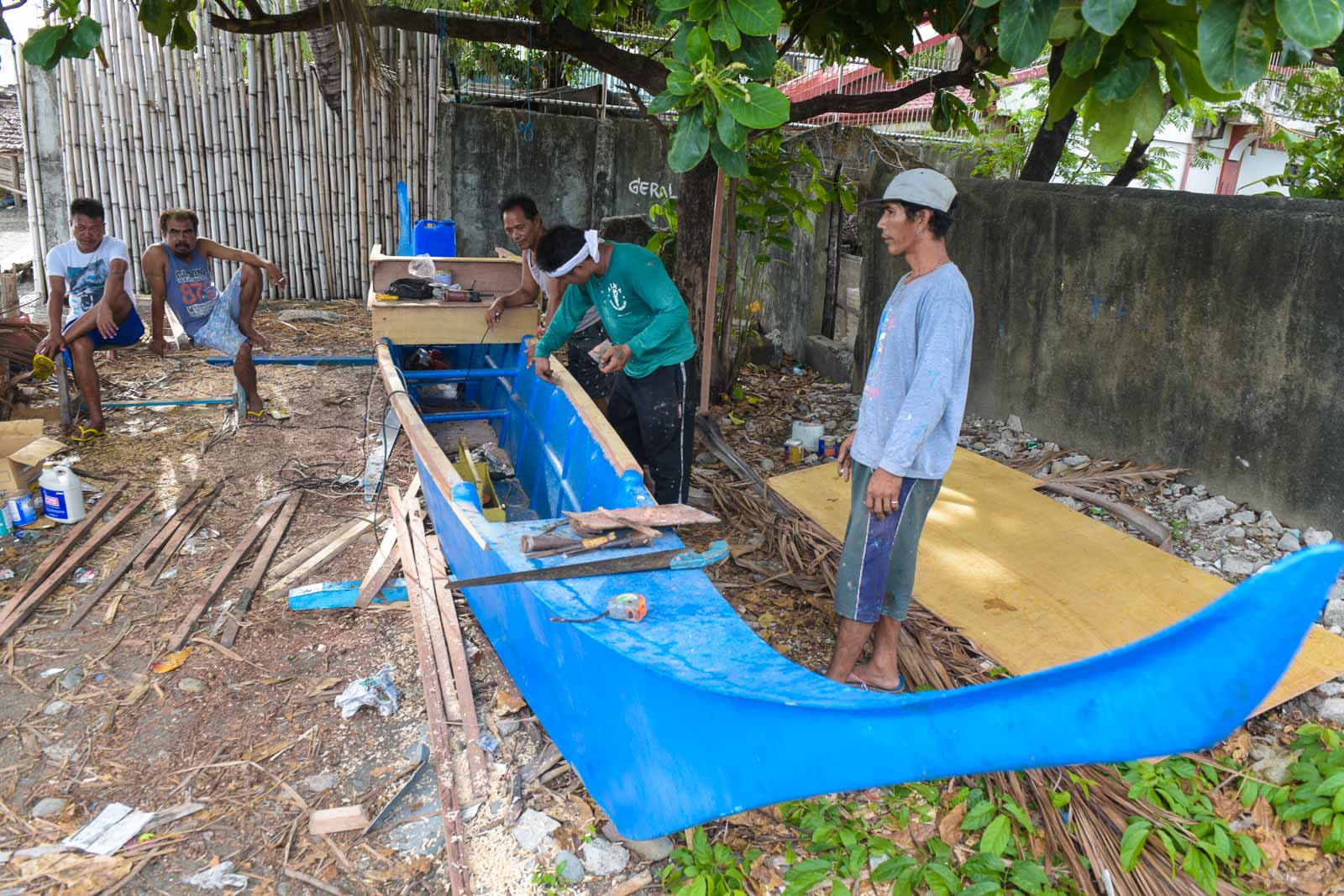
BACK TO WORK. Boy Gordiones (center) makes the necessary refurbishments to his fiberglass boat which he will pass on to his children in the future.
It was Piñol who brought 12 bare fiberglass boats, which were to be shared by Gem-Ver’s 22 fishermen. They turned out to be unfit for immediate use as the engines that came with them were too small for the boat to function. Most laid idle on the beach for days, catching rainwater and attracting children who turned them into play areas.
Boy made do with what was given, as he dreamed of upgrading the boat so it could sail up to Coron, Palawan, some 6 hours away from San Jose. He used the money given to him by government to source plywood and an engine, and hire carpenters.
Not too far from where he worked was the damaged Gem-Ver outside the gates of the Dela Torre home. Fishermen Regan Sta Maria, Lim Gregorio, and Arnel Gadon prepared for the massive repair work, twisting wood and unhinging nails to clean up the rough edges caused by the June 9 ramming incident. The others took turns in washing the disassembled parts of the salvaged boat’s engine.
They worked in silence. It had been less than a month since the Recto Bank incident. A stream of government workers visited the Dela Torre home practically every day, asking the fishermen what else they needed. They brought food packs, disaster preparedness kits, and sacks of rice that began to fill the garage of the Dela Torre home.
As carpenters shaped the wood of Gem-Ver each day, Boy watched over his refurbished boat. “Kung mamatay na ako, bibigay ko ‘to sa mga anak ko,” he said. (When I die, this is what I’ll leave my children.)
But for now, he is staying with Gem-Ver. “Mangingisda pa rin ako sa Gem-Ver. ‘Di ako natatakot,” Boy declared. (I will still fish in Gem-Ver. I am not afraid.)
Soon, the fishermen said, Gem-Ver will be up and running, ready to sail again. – Rappler.com
READ: Profiles | IN THEIR OWN WORDS: The fishermen of Gem-Ver
Video | Gem-Ver fishermen eager to sail again
Add a comment
How does this make you feel?


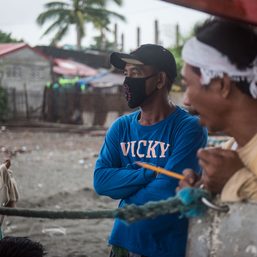

There are no comments yet. Add your comment to start the conversation.